'You fly high up there, mate'
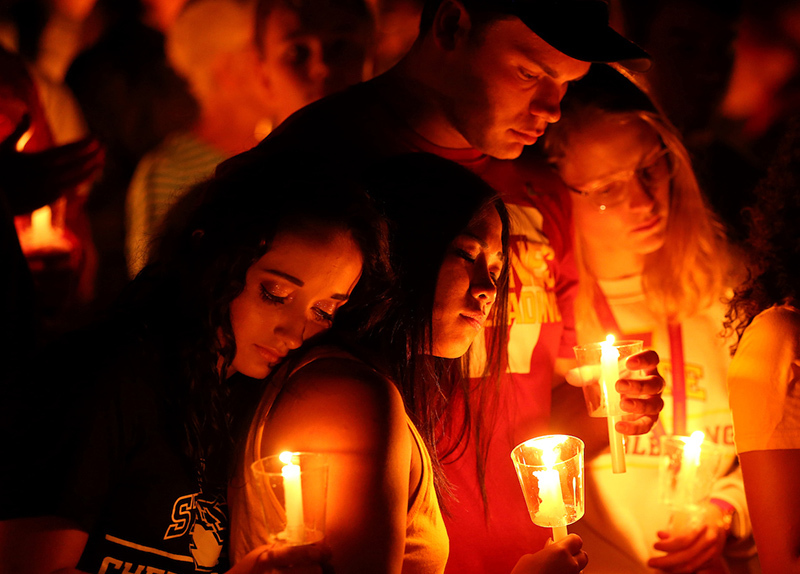
Participants lit candles to conclude a Wednesday evening vigil for slain Cyclone golfer Celia Barquin Arozamena. Photos by Christopher Gannon.
Australian junior Amelia Grohn, a golf teammate and recent roommate to Celia Barquin Arozamena, was among a dozen people who paid tribute to the slain Iowa State student-athlete during a central campus vigil Wednesday evening. More than 1,000 people attended.
Whether her friend, teammate, civil engineering classmate, pastor, teacher or coach, each spoke with great affection for a small woman with a big smile, even bigger aspirations and a work ethic to achieve them. They also recalled a student-athlete who received numerous scholarship offers out of high school but was uncommonly proud to be a Cyclone.
Civil engineering professor Jim Alleman said he was blessed to have her as a student. Despite her many successes in the golf world, she remained "remarkably humble." Because she traveled so much, "her commitment to her studies was critical for her to succeed. But, by gosh, she worked so hard to do that," he said.
Grohn lamented that her friend's dream of qualifying for the women's professional golf tour was cut short, noting that just last month Barquin Arozamena made it through the first stage of qualifying school.
"She had so much left to give to this world," Grohn said. "Celia Barquin Arozamena, you fly high up there, mate. We'll be here making you proud."
Grohn asked Cyclone football fans to wear yellow -- Barquin Arozamena's favorite color -- to Saturday's home game, at which the 2018 Cyclone female athlete of the year will be remembered.
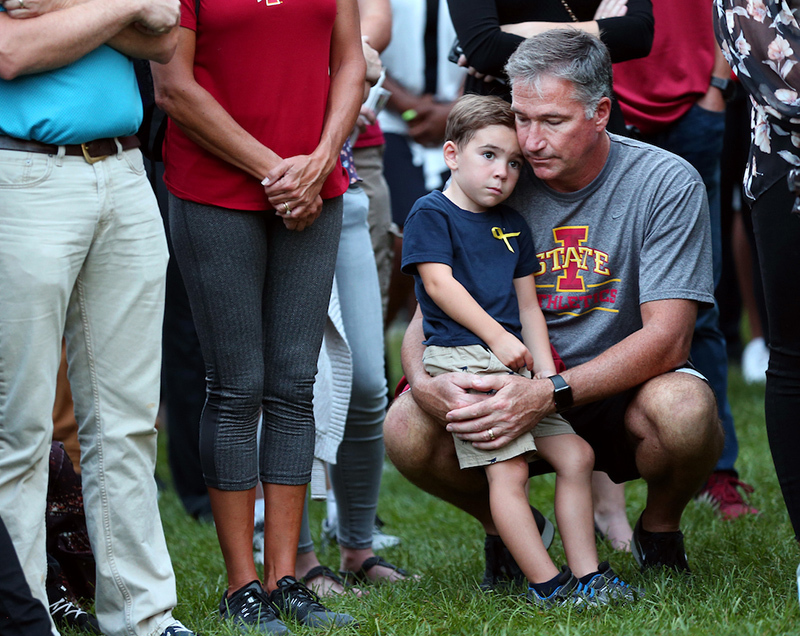
Cyclone gymnastics coach Jay Ronayne holds his son during a moment of silence for Celia Barquin Arozamena at the Wednesday vigil on central campus.
Plant a piece of history after the presidential installation
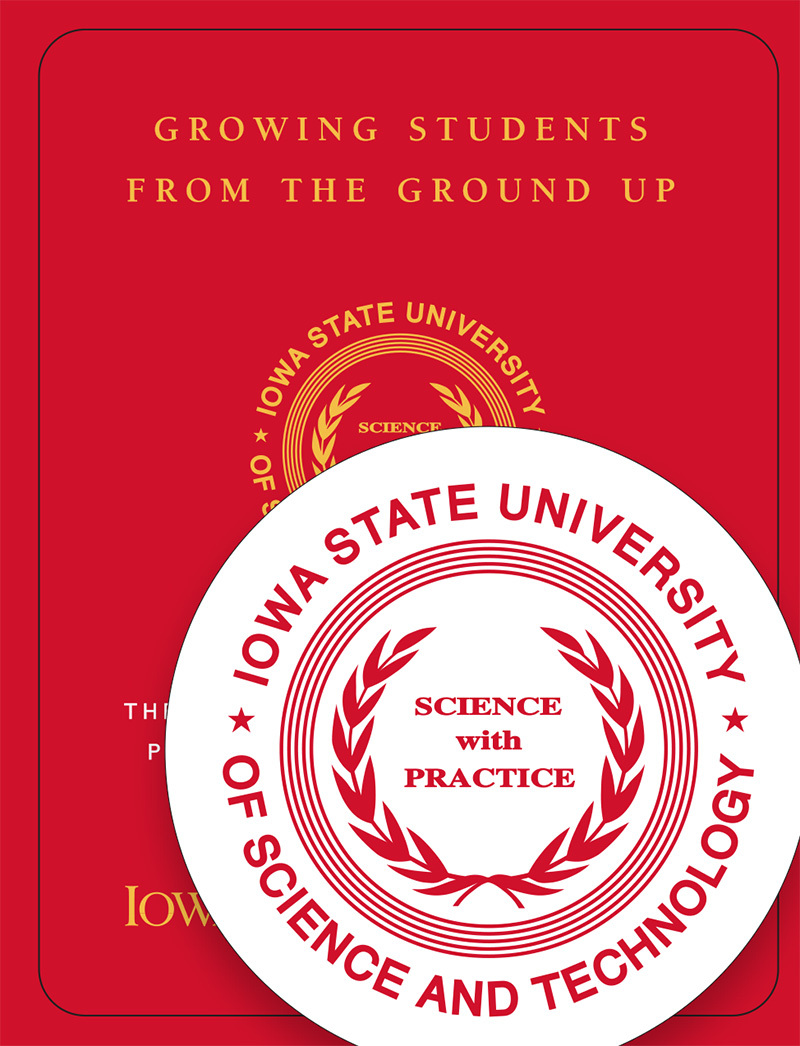
Seed disc and packaging.
As guests arrive at the Sept. 21 presidential installation, they'll receive an annual reminder of the celebration of Iowa State's 16th -- and first woman -- president.
An estimated 2,500 packets containing a wildflower seed disc will be handed out to audience members. The seeds are a nod to President Wendy Wintersteen's long career in agriculture. The commemorative cardinal and gold packaging with a "growing students from the ground up" theme includes a Wintersteen quote and planting directions.
The wildflower mix includes catchfly, English daisy, sweet alyssum, spurred snapdragon, corn poppy and black-eyed Susan seeds. The biodegradable disc -- imprinted with the university seal and embedded with the wildflower seeds -- should be planted in a sunny location next spring.
Installation highlights
The doors of Stephens Auditorium open an hour in advance of Friday's 10:15 a.m. ceremony. Michael Richards, president of the state Board of Regents, will conduct the formal installation following Wintersteen's introduction by ISU President emeritus Gregory Geoffroy.
Installation extras
10:15 a.m., Stephens Auditorium
Gov. Kim Reynolds and representatives from Iowa State faculty, student, staff and alumni groups will deliver brief comments. Wintersteen will lay out her priorities as president in her speech, "To Serve. To Lead. To Excel."
The ISU Wind Ensemble, Iowa State Singers and F. Wendell Miller Distinguished Artist in Residence Simon Estes will perform. Music professor and director of bands Michael Golemo composed an exclusive fanfare, "To Serve," that will debut at the ceremony.
Guests are invited to join the president after the event for a short public reception (noon-1 p.m.) in Stephens' Celebrity Café. The installation ceremony will be livestreamed.
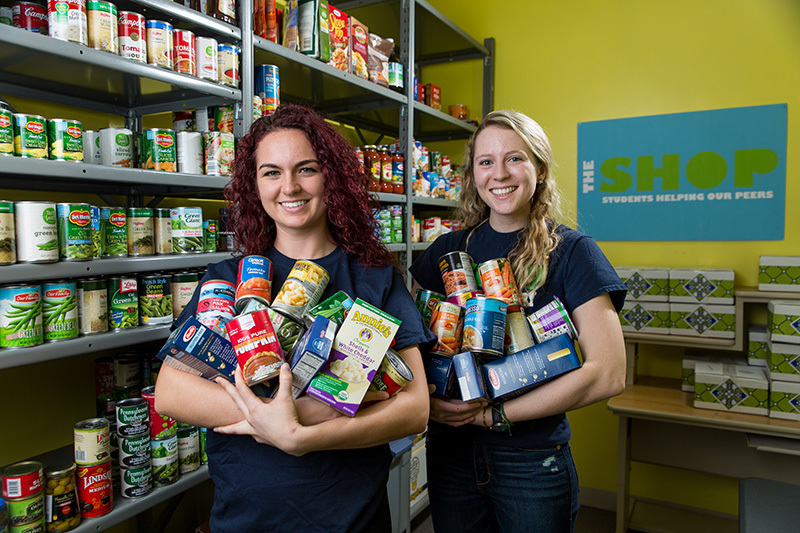
ISU's Student Government planned a picnic and philanthropy effort as part of President Wendy Wintersteen's installation celebration. A student picnic will be held Sept. 20 in the MU Great Hall (11 a.m.-1:30 p.m.). Students are encouraged to donate nonperishable food items for SHOP (Students Helping Our Peers), a student-run campus food pantry. Photo by Ryan Riley.
Child leave options may expand for parents who both work at ISU
For more information
Questions about FMLA? Check out this FAQ from university human resources.
A draft policy change would allow eligible parents who both work at Iowa State to each take up to 12 weeks of leave upon the arrival of a child, expanding what's available under federal law.
The Family and Medical Leave Act (FMLA) allows parents to take up to 12 weeks of leave for the birth of an infant, an adoption or the placement of a foster child. But when the parents share the same employer, the federal law limits leave to care for a new child to a combined 12 weeks between the parents. The policy change Iowa State is considering would override that limitation for parents who both work at the university. It would apply to all faculty and staff.
Giving 12 weeks to both ISU-employed parents is a family-friendly move that demonstrates the university's care for employees and their roles outside the workplace, said Andrea Little, manager of employee and labor relations for university human resources (UHR).
"We want to be able support the holistic well-being of our employees, which includes the roles they hold outside of work as a parent," Little said.
Depending on the circumstances, employees may use paid vacation or sick time during an FMLA leave, which otherwise is unpaid. Policies concerning the use of paid leave during an FMLA absence wouldn't be affected by this change. To qualify for FMLA, employees must have worked for Iowa State for 12 months and at least 1,250 hours in the 12 months prior to the leave.
UHR has been working to develop the policy change since last fall, with the support of senior leaders, Little said.
Stakeholder groups including the Faculty Senate and the Professional and Scientific Council have been invited to provide input, she said. Iowa State employees also are encouraged to weigh in on the change. The public comment period for the policy runs through Sept. 30. Send comments to policy@iastate.edu.
Depending on the feedback received, the new policy could go into effect by the end of 2018 or in early 2019, Little said.
Faculty hires respond to resignations, program growth
Iowa State hired 62 tenured (13) or tenure-track (49) faculty from September 2017 through last month, the smallest group in at least five years. In the prior year, the university hired 80 tenured or tenure-track faculty in the same period. But with enrollment leveling off and state operating support declining for a second year, that's a good hiring year, said associate provost for faculty Dawn Bratsch-Prince.
"The budget definitely is a factor. With two years of midyear reversions, we were taking a more subdued approach to hiring," she said.
She also called several years when the new faculty number exceeded 100 -- running as high as 123 -- "extraordinary."
Bratsch-Prince said most of the past year's hires were in response to retirements or resignations. There were 44 resignations among tenured and tenure-track faculty the previous year, according to an annual report to the state Board of Regents.
Some hires, she noted, also were due to program growth, for example in the Ivy College of Business. Across the college, 16 faculty joined its ranks, roughly 18 percent of all tenured and tenure-eligible Business faculty last fall. The supply chain and information systems department, which is in the process of splitting into two due to growth, hired seven faculty members in the last year. The math department in the College of Liberal Arts and Sciences has a multi-year strategy to grow its faculty numbers, at least partly still in response to the rapid enrollment growth of three to five years ago, Bratsch-Prince said.
Students continue to seek out majors in the STEM fields, big data and data analytics, she said.
The faculty hires included four full professors. Bratsch-Prince noted hires at that level typically meet specific circumstances, such as:
- Hiring a department chair
- Filling a vacant endowed faculty position
- Elevating the regional or national prominence of an academic program
- (Less common) Identifying an appropriate position for a faculty spouse or partner
Tenured and tenure-eligible faculty hires: Sept. 2017-Aug. 2018
|
College/department |
Professor |
Associate professor |
Assistant professor |
Total |
|
Agriculture and Life Sciences |
|
|
|
2 |
|
Animal science |
|
|
1 |
|
|
Food science and human nutrition |
|
|
1 |
|
|
Business |
|
|
|
16 |
|
Accounting |
|
|
2 |
|
|
Finance |
1 |
|
1 |
|
|
Management |
1 |
1 |
1 |
|
|
Marketing |
|
1 |
1 |
|
|
Supply chain and info systems |
|
1 |
6 |
|
|
Design |
|
|
|
10 |
|
Architecture |
|
1 |
1 |
|
|
Art and visual culture |
|
|
1 |
|
|
Community and regional planning |
|
|
1 |
|
|
Industrial design |
|
1 |
|
|
|
Interior design |
|
|
4 |
|
|
Landscape architecture |
|
|
1 |
|
|
Engineering |
|
|
|
9 |
|
Aerospace |
|
1 |
2 |
|
|
Agricultural and biosystems |
|
1 |
1 |
|
|
Civil, construction and environmental |
1 |
|
|
|
|
Electrical and computer |
|
|
1 |
|
|
Industrial and manufacturing systems |
|
|
2 |
|
|
Human Sciences |
|
|
|
1 |
|
Apparel, events and hospitality management |
|
|
1 |
|
|
Liberal Arts and Sciences |
|
|
|
20 |
|
Computer science |
1 |
|
|
|
|
Economics |
|
1 |
1 |
|
|
English |
|
|
1 |
|
|
Genetics, development and cell biology |
|
|
1 |
|
|
Geological and atmospheric sciences |
|
|
1 |
|
|
Greenlee School |
|
1 |
2 |
|
|
Mathematics |
|
|
4 |
|
|
Music and theatre |
|
|
2 |
|
|
Psychology |
|
|
2 |
|
|
Statistics |
|
|
2 |
|
|
World languages and cultures |
|
|
1 |
|
|
Veterinary Medicine |
|
|
|
4 |
|
Clinical sciences |
|
|
1 |
|
|
Microbiology and preventive medicine |
|
|
2 |
|
|
Pathology |
|
|
1 |
|
|
Total |
4 |
9 |
49 |
62 |
Congratulations
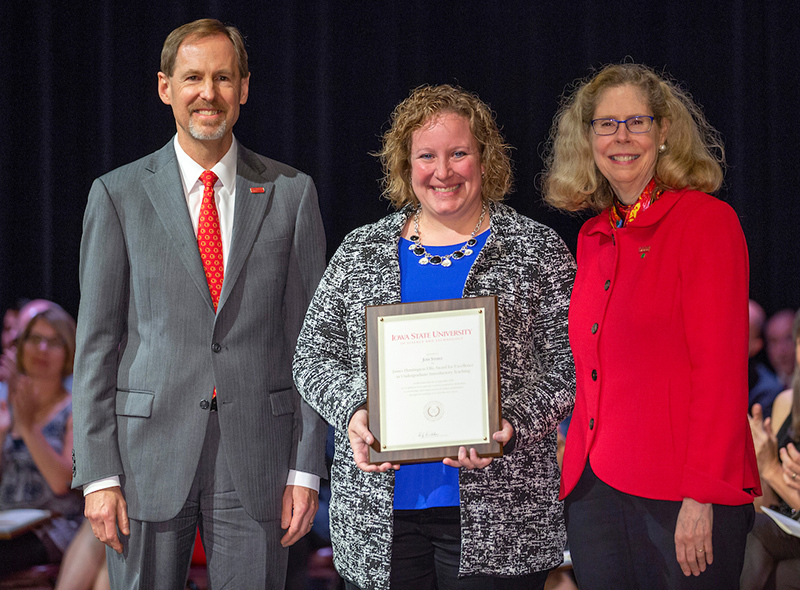
Photo by Christopher Gannon.
Jodi Sterle (center), associate professor of animal science and the Harman Endowed Professor, received the James Huntington Ellis Award for excellence in undergraduate introductory teaching during the university awards ceremony Sept. 14. She is congratulated by President Wendy Wintersteen and senior vice president and provost Jonathan Wickert.
Nearly 60 individuals were honored that afternoon with the university's highest awards for faculty and staff.
New Miller grants support better course materials, for free
The inaugural Miller Open Education Mini-Grants awarded this summer are helping Iowa State faculty develop, adapt and share instructional materials that save students money while enriching their classroom experiences.
The $50,000 program to support open educational resources (OER) provided small grants to 13 individuals or teams who want to use free, openly licensed course materials, or those who want to refine, expand and release OER materials they're already employing. Grant guidelines favored proposals that aim to improve teaching methods, said Abbey Elder, open access and scholarly communications librarian.
"Though we want to encourage student savings and OER adoption on campus, our aim wasn't just, 'Adopt an open textbook.' It was, 'Change how you teach the course,'" said Elder, who coordinated the grants. "By using or creating OER, you can make the class your own."
Advisory groups from the Center for Excellence in Learning and Teaching (CELT) and the library reviewed 27 proposals. The grants were distributed in July. Some materials already are in use this fall, while others will be developed for 2019, Elder said.
Faculty who received grants are required to place their materials in the library's digital repository, making them available to instructors anywhere, and complete a report and a panel presentation on their project, Elder said. They'll also be encouraged to mentor colleagues seeking to offer similar OER course materials.
Following are summaries of the winning proposals and the estimated savings per student:
Boris Jovanovic, natural resource ecology and management, and Evrim Baran, School of Education
Award: $5,000
Course: NREM 50X, Aquatic Toxicology
Summary: In this spring 2019 graduate course, Jovanovic's students will collaboratively write a wiki-style textbook that future classes can build upon. Small student teams will work together to write chapters, which Jovanovic will edit. Baran has experience in open pedagogy and will assist in the process, as well as assess learning outcomes.
Savings per student: $370
Young-Jin Lee, chemistry
Award: $2,000
Course: CHEM 211, Quantitative and Environmental Analysis
Summary: Lee is adopting an existing open textbook and creating or adapting supplementary materials to build upon the text.
Savings per student: $180
Eric Olson, apparel, events and hospitality management
Award: $5,000
Course: EVENT 471, Special Events Coordination
Summary: Olson is identifying and collecting OER materials, which are scarce in the event management field, to replace a required textbook. He's also creating team-based learning activities based on the OER.
Savings per student: $130
Sara Pistolesi, chemistry
Award: $9,950
Courses: CHEM 163L, 167L, 177L and 178L, general chemistry laboratories
Summary: Pistolesi is creating step-by-step visual manuals for experiments conducted in these 100-level chemistry labs.
Savings per student: $100
Dennis Lavrov, ecology, evolution and organismal biology
Award: $4,950
Course: EEOB 563, Molecular Phylogenetics
Summary: Lavrov's redesign of this course is using open resources in an integrated way. In addition to adopting an existing open textbook, he's creating OER tutorials and exercises for the materials and moving the course website to an open-source platform.
Savings per student: $100
Reza Montazami, mechanical engineering
Award: $4,000
Course: ME 370, Engineering Measurements
Summary: Montazami is compiling hand-written lecture notes he already was making available to students to create a new open textbook, updating and organizing them along the way.
Savings per student: $77
John Haughery, agricultural and biosystems engineering
Award: $580
Course: TSM 363, Electric Power and Electronics for Agriculture and Industry
Summary: This fall, Haughery is testing an open textbook in his TSM 363 class.
Savings per student: $75
Craig Ogilvie and John Lajoie, physics and astronomy
Award: $2,000
Course: PHYS 241/242, Introduction to Classical Physics I and II
Summary: Ogilvie and Lajoie used open resources before these grants were offered but are developing assignments to pair with the OER textbooks in these courses.
Savings per student: $64
Peter Moore, natural resource ecology and management
Award: $4,960
Course: NREM 240, Quantitative Problem-Solving in Natural Resources
Summary: Moore has been writing a textbook for this course, which was first taught on an experimental basis in 2014. The grant assisted in the editing and formatting of the book, which is designed to support flipped and hybrid course structures.
Savings per student: $60
Michael Brown, School of Education
Award: $4,000
Course: RESEV 552, Basic Educational Statistics
Summary: Brown has shifted from teaching this graduate course with a proprietary statistical analysis software to a free application, giving students a better chance of applying what they learn after the course is complete. He's incorporating an OER textbook and in-class labs based on public data.
Savings per student: $50
Larysa Nadolny, School of Education
Award: $2,500
Course: C I 202, Learning Technologies in the 7-12 Classroom; and C I 505, Using Technology in Learning and Teaching
Summary: Nadolny is building modules on copyright and fair use issues in K-12 classrooms. Though designed for these two courses, the modules will be available through Canvas Commons and could be used in any course for future K-12 educators.
Savings per student: $25
Shenglan Zhang, world languages and cultures
Award: $1,600
Course: CHIN 102, Elementary Mandarin Chinese II
Summary: Zhang is collecting video and audio recordings demonstrating the proper use of tones in Chinese speech.
Savings per student: $0
Jen McClung, English
Award: $1,500
Course: AM IN 20X, Native People in American Culture
Summary: McClung is creating lesson plans for this new course mostly from scratch, building a curated list of open-access examples of contemporary Native American voices in culture.
Savings per student: $0
The grants, sponsored by the library, CELT and the office of the senior vice president and provost, were funded in part by the Miller Endowment Trust, which supports faculty development. The trust was created by the estate of F. Wendell Miller, an attorney and farm manager who died in 1995 and left the bulk of his estate to Iowa State and the University of Iowa. Grants will be offered again in the spring for fiscal year 2020, Elder said.
Planning will resume for a scaled-back veterinary lab
Proposals to add doctoral programs in education at Iowa State and the University of Iowa will go to the full state Board of Regents in November but, during the Sept. 12 meeting in Iowa City, members of the board's academic affairs committee expressed concern about perceived duplication. And at least one committee member was concerned about a negative impact on the existing doctoral program at the University of Northern Iowa.
Regent Larry McKibben said he wants "zero harm" to the UNI program and no overlap among the three schools' doctoral programs.
"The state's finances won't allow it," he said.
Officials from all three schools reported extensive collaboration in the process of developing the two new programs (Ed.D.). Iowa State's would offer two professional tracks (community college and school district administration); Iowa's would serve those seeking to lead in school, district or higher educational settings. Northern Iowa's interdisciplinary Ed.D. offers three specialty areas, for example, one in allied health, recreation and community services.
Iowa State and Iowa also offer Ph.D. programs in education.
Graduate College dean Bill Graves told the regents that even with three public Ed. D. programs, the demand in the state will exceed the available spaces in them.
Planning resumes for Veterinary Diagnostic Lab
Both the property and facilities committee and the full board approved Iowa State's request to begin planning a $75 million Veterinary Diagnostic Laboratory (VDL) on the Veterinary Medicine campus. The 2018 Legislature committed $63.5 million in state support to the project over six years, beginning with $1 million for project planning in the current year. Last fall, Iowa State requested $100 million in state support for a proposed $124 million lab based on a 2014 needs study.
President Wendy Wintersteen said, "We're going to do a great job this year, planning and understanding what we can get done for the dollars available, and then we'll have some more conversations after we get through that process.
"This is a critical facility, really not just for Iowa State, as much as it is for Iowa, the nation and the world," she added. "If we don't understand diseases that are occurring [on livestock and poultry operations], then we really can't prepare for the future."
McKibben thanked her for "staying the battle and finding a way to keep it moving forward."
"Those of us in agriculture know the value of the facility," McKibben said.
FY20 funding needs
Wintersteen told board members Iowa State will need $32.5 million in new resources next year (a combination of increase to general university appropriation, new tuition, savings and strategic realignments) to make headway on four priorities:
- Faculty and staff retention
- Faculty and staff recruitment (to lower student-faculty ratio – a quality indicator -- and meet growth in STEM programs)
- Building maintenance and capacity, including deferred maintenance
- Support for need-based student financial aid to improve graduation rates for all students, especially first-generation, low socio-economic or multicultural students.
The requested state portion of that new funding next year is about $7.4 million: a 4 percent increase ($7 million) to the general university operating budget, designated for student financial aid; and a 10 percent increase ($410,000) to VDL operating support.
"We will continue to leverage every dollar we receive to provide an excellent return on investment for our students and for the state," Wintersteen said. "We have been a faithful partner for Iowa and for Iowans in all 99 counties for the past 160 years. And we look forward to building a bright future together."
Timing of tuition discussion will move up
Board president Michael Richards used his commentary time to outline a "holistic approach" to funding the three state universities.
"I believe strongly that we can't continue to look at these segments of funding -- state appropriations, savings and reallocations, tuition and all research funding -- individually. We need to look at them in terms of total resources. The combination of funding in these areas must equal the total resources needed for a given year," he said.
"Finding the right mix is the challenge, but in the end, we need to arrive at a total resources number."
Richards said the board's tuition discussion will begin earlier this year. At the next meeting (November), he said the board would discuss "a multiyear tuition model with a baseline percentage increase for resident undergraduates for the next several years." That would include specifics about the potential ranges of tuition increases. A formal reading of tuition rates would come yet this calendar year, he said.
Last year, the board opted to delay setting tuition rates until after the 2018 Legislature had adjourned.
Library learning hub
In approving a five-year capital plan for the regent universities, the board approved an Iowa State $28 million proposal to renovate 44,000 square feet of stacks space on two floors of the library for a student learning hub, adding an estimated 600 seats, technology-equipped group collaboration spaces and classrooms. The plan starts with $10 million in FY 2020 (academic building revenue bond sale or an appropriation), with $16 million in state support the following year and $2 million in gifts or university funds.
Who stays?
Wintersteen told board members Iowa State awarded 8,356 degrees during the 2017-18 academic year. Among those graduates:
- 62 percent of in-state graduates remain in Iowa
- 22 percent of nonresident graduates remain in Iowa
- 29 percent of international graduates remain in Iowa
Other business
These ISU construction projects received final board approval:
- Recreation services' plan to invest $10 million in the recreation fields east of Jack Trice Stadium. The plan renovates and reconfigures the area and adds an irrigation system, lights and restrooms.
- A $4.2 million replacement of a steam line at the Iowa State Center that services all four buildings.
These proposals cleared a board committee review and go to the full board in November for final approval:
- Adding a bachelor of science degree in cyber security engineering in the electrical and computer engineering department. The proposed start date is August 2019.
- Reorganizing the supply chain and information systems department in the Ivy College of Business to two departments: supply chain management, and information systems and business analytics. The proposed effective date is July 1, 2019.
- Closing five centers for which activities either ceased or were picked up by another unit: Biosafety Institute for Genetically Modified Ag Products, Center for Carbon Capturing of Crops, Center for Sustainable Environmental Technologies, Midwest Forensics Resource Center, and Nutrition and Wellness Research Center.
